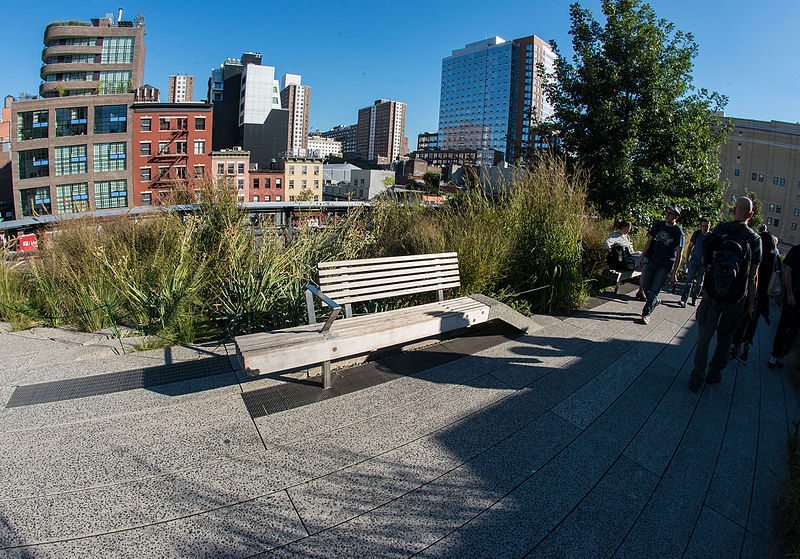Running through the inner Sydney suburb of Ultimo is the future of urban planning. The Goods Line, announced in November of last year, has the potential to rejuvenate the often overlooked space between Ultimo and Haymarket in Sydney CBD’s fast changing southern fringe.
Until recently, “SoBa” (South of Bathurst Street) was a place dominated by cheap eateries, discount clothing stalls, armament stores and sad-looking pubs. The region around Central Station received a facelift in the late 1990s with the building of Henry Deane Plaza and the rake-like Railway Square bus stand, however it suffered from a contagion of crapness from the surrounding areas. Of late, the area has been the focus of some renewal, with the tone of retailers in the Railway Square area rising a few notches and interesting (if controversial) developments along Broadway around the University of Technology. However it is the proposed Goods Line that has the potential to really transform the area and turn it into a social, cultural and even tourist hub for Australia’s largest city.
The Goods Line is the new name for the disused freight railway line running between the end of the Devonshire Street Pedestrian Tunnel extension beyond Railway Square to Darling Harbour near the Powerhouse Museum. The initial stretch will follow the
existing corridor behind the ABC building, before jumping Ultimo Road by way of a heritage bridge and then continuing alongside Darling Drive behind Paddy’s Market. Previously known as the Ultimo Pedestrian Network, the Goods Line’s vision is for a green garden space similar to that of New York City’s High Line, another disused railway line. The High Line opened to critical acclaim in 2009, an elevated walkway featuring gardens, stalls, quiet spaces, and even an amphitheatre. The results have been impressive – the areas immediately surrounding the park underwent a good deal of gentrification, and up to thirty new developments were planned in the vicinity, according to the High Line’s Wikipedia page. The success of the project and subsequent resurgence of interest in the area spurred a continuation of the line, yet to be opened. Most of Sydney’s Goods Line will be at ground level, with the Ultimo Road flyover the main elevated part, while the High Line is several stories above the street at many points. Sydney’s Goods Line probably owes more to the original railway-turned-green space,
the Promenade Plantée in Paris. The High Line of New York City totals over two kilometres in length, while Sydney’s Goods Line will only measure 500 metres, but the potential is the same. The futuristic development, snaking among the buildings like something out of SimCity, could transform not just the Ultimo area, but the way we look at urban redevelopment altogether.

New York City High Line (Image: US Department of Agriculture, Wikimedia Commons)
However local blog Penultimo has been among a couple of commentators to point out that the Goods Line differs from the High Line in its fundamental purpose. While the High Line serves as a destination for both locals and tourists, the Goods Line is essentially a transport corridor, conveying commuters from Central Station at one end to Darling Harbour at the other. “When Darling Harbour was built in the 1980s, all focus was on the harbour area as a destination, and little attention was given to pedestrian linkages, particularly on the western side” contends Penultimo. “The Goods Line, on the other hand, is precisely intended as a linkage point, a mode of urban connectivity. It will probably attract people who just want to spend time there – but it must serve the existing community of locals, students, workers, who essentially want to move smoothly from one end to the other. If it does not do this, it will be immensely frustrating.” The Penultimo article goes on to suggest that a Goods Line filled with outdoor furniture, flower beds and playgrounds would not necessarily be conducive to cyclists, forcing them to remain on the already congested roads. This is an issue raised by Sydney Morning Herald readers in response to the announcement of the development last November. One comment suggested to “make any bike route a straight line, and separated from pedestrians, if it is to be of any use”, while another called it “a pedestrian slalom course for bicycles” which is a “recipe for accidents”.
Whatever ends up happening, designers Choi Ropiha Fighera and Aspect Studios have a careful balancing act ahead of them. Sydney is a famously cynical city when it comes to urban development, and a project as experimental as this could divide its patrons once the doors are thrown open.
The Goods Line is currently slated for opening in late 2013 or early 2014. For more information and artist’s impressions of the Goods Line, check out Aspect Studios.




0 Comments